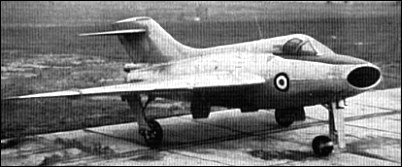|
| The Boulton Paul P.111 and P.120
delta wing research aircraft, built to Air Ministry Specification E.27/46 and E.27/49 respectively, were used to investigate high speed characteristics of the delta wing.
The P.120, flown on 6 August 1952, was similar in general layout to the P.111 but had an all-moving tailplane mounted on a squat fin. There was little chance to gain much information from the new aircraft as it was lost on 29 August, in an accident thought to have been caused by tail flutter.
| ENGINE | 1 x 2315kg Rolls-Royce RN.2 Nene |
| WEIGHTS |
| Take-off weight | 5711 kg | 12591 lb |
| Empty weight | 4838 kg | 10666 lb |
| DIMENSIONS |
| Wingspan | 10.19 m | 33 ft 5 in |
| Length | 9.02 m | 30 ft 7 in |
| Height | 2.90 m | 10 ft 6 in |
| Wing area | 26.95 m2 | 290.09 sq ft |
 | A three-view drawing (900 x 745) |
| M.D.Saunders, e-mail, 10.12.2010 23:04 The aircraft suffered a failure of an elevon, the pilot Ben Gunn becoming the first pilot to eject from a delta winged jet aircraft. reply | | paul scott, e-mail, 18.08.2009 18:58 Yes, Tony, you were privileged indeed, the golden age of, although post-war austerity, imagine what Britain COULD have done. (Especially if it wasn't for Duncan Sandys disastrous white paper of 1957). If only Churchill's daughter had met someone else! reply | | tony catt, e-mail, 17.03.2009 21:38 I saw the P111a fly at farnbourgh and apart from the SWIFT became my favorite aircraft,although I spent many hours around Boscombe Down in the 50s I never saw the P120 so to me it was a great loss. I always felt that like many of the great aircraft that were designed and flown in the 50s many were not given the time to prove themselves. Its good to look back and be able to say :I saw that aircraft fly : reply |
|
Do you have any comments?
|
| 
COMPANY
PROFILE
All the World's Rotorcraft
|








